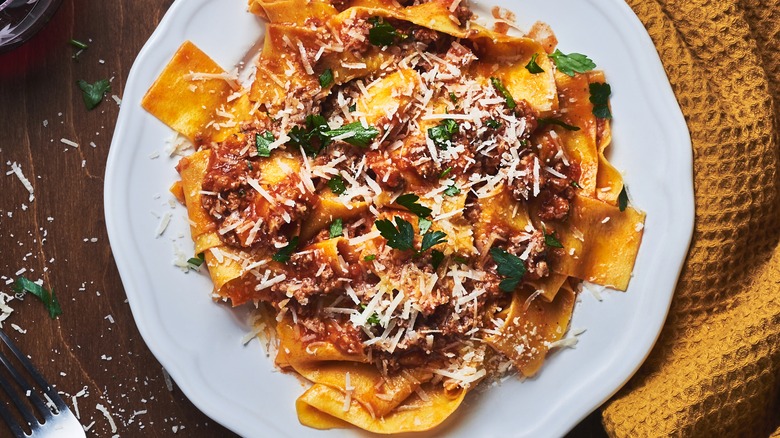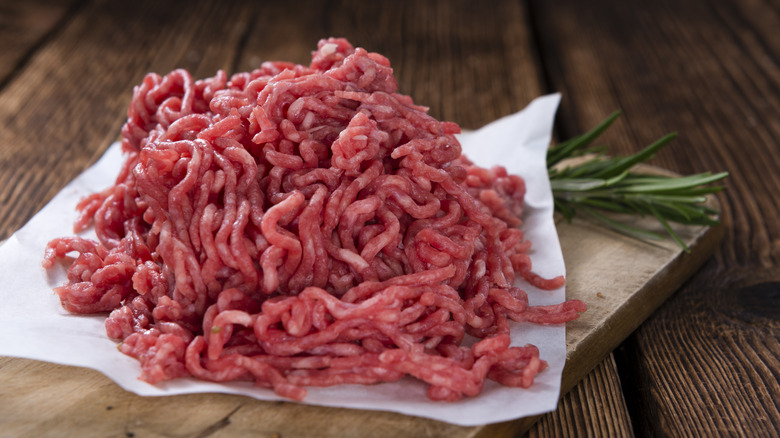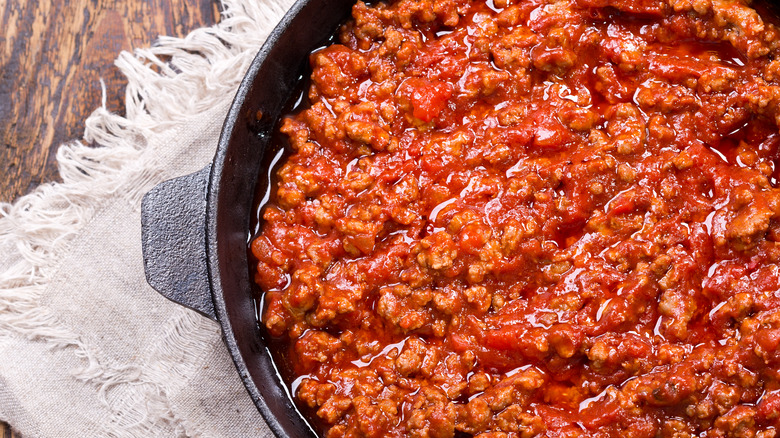The Best Type Of Meat To Use For Bolognese
Few recipes have a history as deep as ragu Bolognese. What was born as a ragout in France, migrated to become an Italian staple, and continued to the United States where it's virtually synonymous with humble jarred tomato sauce (via Travel Emilia Romagna). Its fame is only rivaled by the debates over how to make it and what to include.
Without diving into all of that, most cooks agree that Bolognese is a long-simmered tomato-based sauce that's enriched with meat, dairy, and wine that's served with pasta. But, each of those ingredients spurs a debate. Fresh pasta or dried? Does shape matter? Canned tomatoes are fine but should they be whole, crushed, or pureed? Red wine or white?
Even the Italian government's official recipe includes an optional ingredient. To further confuse the issue, La Cucina Italiana lays out how there's even an ongoing battle to decide on Ragu Bolognese's home. Bologna's mayor has weighed in, via Twitter, that spaghetti Bolognese doesn't even exist in Italy.
Traditional meats for bolognese
The biggest decision that will impact your own Bolognese is the meat you decide to add. At least, that's what culinary consultant and recipe developer J. Kenji López-Alt says in a serious eats piece.
According to López-Alt, Bolognese recipes always use a variety of meats and ground beef is the foundation for Bolognese. Low and slow-cooked ground beef maintains a hearty texture in addition to all that beefy flavor. Adding ground pork brings extra fat that renders a velvety texture. But, ground pork's flavor takes a back seat to the more assertive beef. Combining these two is key.
Like a standard "meatloaf mix," veal is the third type of traditional meat, although not as regularly found in the supermarket as pork and beef (via We Are Chefs). What veal lacks in flavor, it makes up for it by providing ample gelatin. Gelatin is a protein that dissolves into slow-cooked sauces and yields a silky, stick-to-your-ribs hearty texture to a sauce.
Bolognese upgrades
Each of those three classic ingredients can be supplemented or enhanced. You can skip the veal and add gelatin to the broth you'll use to simmer your Bolognese. Chef Jon Ashton uses gelatin in his recipe and Adam Eaton uses it in his Moose Bolognese. López-Alt explains that gelatin can help home cooks ensure a silky, unctuous Bolognese without adding a bland or tough-to-find ingredient.
Ground beef and pork may seem irreplaceable for a classic Bolognese, but the addition of lamb can really up the meatiness. Americans barely eat lamb, according to The Boston Globe, but it's a great way to add meaty depth and complexity. Bolognese is a perfect excuse to use ground lamb.
For even deeper complexity, how about chicken livers? They're not just for chicken liver pate, but a historic addition to Bolognese that's been set aside, for the most part. López-Alt notes, "Liver adds flavor and depth to the sauce in a way that sits in the background. Nobody who tastes the sauce would ever suspect that there are livers in it."


